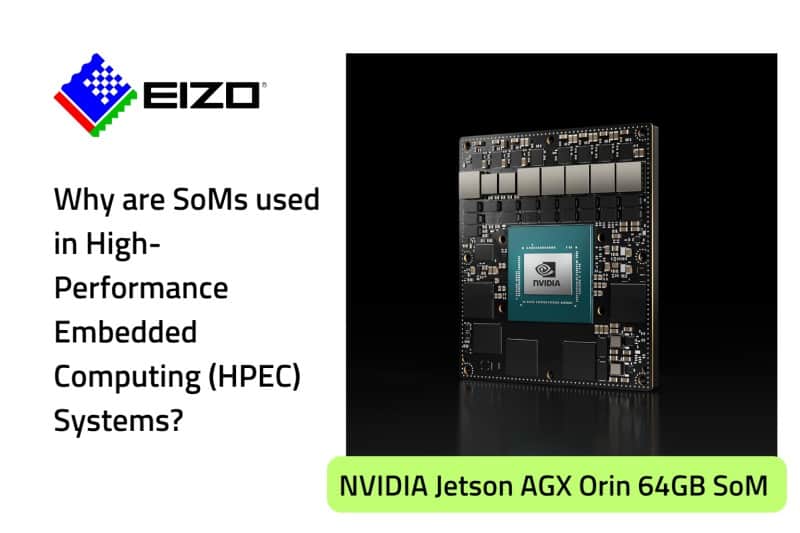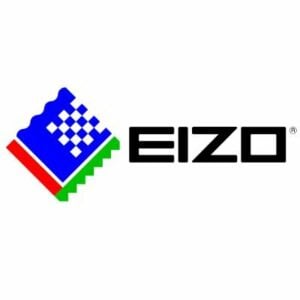EIZO Rugged Solutions explains some key advantages of using a 3U VPX Single Board Computer (SBC) with a System on a Module (SoM) over a dual card solution that uses both a XMC and VPX module configured together in a high-performance mission system.
What is a System on Chip vs. a System on Module?
A System on Chip (SoC) is a highly Integrated Circuit (IC) that combines the functionality of multiple components into a single chip, including microprocessors, I/O interfaces, and various hardware accelerators. SoCs are designed to provide high performance, low power consumption, and compact size, making them ideal for SWaP-C-constrained high-performance embedded computing systems.
A System on a Module (SoM) takes this concept further by integrating an SoC IC with other parts like Memory onto a PCB and then routing all I/O to a high-speed connector. While more limiting in design footprint than a base SoC, it reduces software integration complexity. It also improves overall design reliability as the complex interconnects are thoroughly vetted by the chip design company.
Why are SoMs used in High-Performance Embedded Computing (HPEC) Systems?
The SoMs we focus on typically have powerful CPUs, GPUs, video encode/decode engines, and other hardware accelerators (such as Tensor Cores) to improve the throughput of specific tasks like data processing, Deep Learning (DL), and Vision Acceleration, all of which is done with a relatively small footprint.
The value of SoMs is that all this is included within a single entity which allows better optimization via shared buses and enables built-in security features to be more easily integrated to ensure the protection of sensitive data and the prevention of unauthorized access. This is critical for SWaP-C-constrained HPEC systems, where high throughput processing is essential for system control, feedback, and decision-making tasks.
Reduced Latency & Higher Bandwidth
SoMs have an integrated shared memory controller between their various components, significantly minimizing unnecessary memory copies over a potentially bottlenecked bus found in various dual-card solutions that rely on independent memory fabrics.
For example, dual-card solutions with GPU XMC and SBC VPX modules require data to be transferred between these cards via a PCIe fabric. This discrete memory copying between each device’s memory bank must also be tightly arbitered by the CPU, creating data bandwidth challenges and limiting the designers’ ability to streamline operations and achieve performance goals.
There are several other advantages to using a 3U VPX Single Board Computer (SBC) with an SoC over a dual card solution with XMC and VPX modules as well including:
Reduced Size, Weight, and Power (SWaP): A 3U VPX single board computer with an SoC combines the functionality of multiple cards into a single, compact solution. This reduces the SWaP consumption of the overall system, making it more suitable for applications that require low SWaP processing capabilities.
Higher Performance: SoMs have higher performance per watt than XMC and VPX modules, thanks to their integrated hardware accelerators and shared memory fabric.
Improved Reliability: A single-board computer with SoM is less prone to hardware failures than a dual-card solution, as it eliminates multiple other inter-card connections, which can all be points of failure.
Easier Integration: A 3U VPX single board computer with an SoM simplifies system integration, as it requires fewer cards and components to be integrated at the end site. This also reduces long-term maintenance complications as a single source provides the complete solution.
Introducing the NVIDIA Jetson AGX Orin
The NVIDIA Jetson AGX Orin SoM features an NVIDIA Ampere GPU with 2048 CUDA cores and 64 Tensor Cores. This GPU architecture delivers up to 275 TOPS (trillion operations per second) of AI performance, enabling real-time inference for AI applications. The Jetson AGX Orin SoC features twelve Arm Cortex-A78AE CPUs specifically designed for high-performance embedded applications. This high-bandwidth memory enables efficient data transfer between the CPU, GPU, and other processing units.
In addition to the GPU, the Jetson AGX Orin SoM also features dedicated AI accelerators, including two NVDLA engines and two vision accelerators. These accelerators enable the efficient execution of deep learning models and other AI workloads. The Jetson AGX Orin SoM supports hardware-accelerated video encoding and decoding, including support for H.265 (HEVC) and H.264 (AVC) codecs. This enables efficient video processing for surveillance, sensor processing, and autonomous vehicles. The Jetson AGX Orin SoM supports various connectivity options, including PCIe Gen4, Gigabit Ethernet, USB 3.2, and 10 GbE. This enables high-speed data transfer and communication between the Jetson AGX Orin SoM and other devices in the system.
Overall, the NVIDIA Jetson AGX Orin SoM is a powerful and efficient solution for AI and deep learning applications, with advanced GPU and CPU performance, high-bandwidth memory, dedicated AI accelerators, and a wide range of connectivity options.
EIZO’s High-Performance 3U VPX SBC with NVIDIA Jetson AGX Orin
Targeted for I/O-intensive C5ISR applications requiring At-the-Edge computing, EIZO has released the Condor AGX-IOX, a 3U VPX SBC designed for rugged embedded processing applications such as multi-sensor mission systems. The Condor AGX-IOX supports up to 64GB of LPDDR5 memory, which delivers up to 205GB/s of memory bandwidth.
The Condor AGX-IOX 3U VPX SBC supports advanced storage and networking capabilities, including 64GB eMMC internal storage and 10GbE (Gigabit Ethernet), and high-speed I/O such as USB 3.2, DisplayPort, and RS-232 Serial. The Condor AGX-IOX is designed to support VITA 46/65 and the Sensor Open System Architecture (SOSA) technical standards slot profile 14.2.16.
This solution provides customers with lower Size, Weight, and Power (SWaP) and increased performance per watt with the ARM CPU and the NVIDIA GPU configured on a single module. For a maximum 60 Watt single-slot solution, the Condor AGX-IOX 3U VPX card significantly increases the speed and efficiency of data processing in multi-sensor systems, allowing for real-time detection and analysis of incoming signals and data.
EIZO Rugged Solutions designs and manufactures ruggedized High-Performance Embedded Computing (HPEC) hardware with NVIDIA Jetson modules. These solutions target compute-intensive edge processing applications such as Signal Intelligence (SIGINT), Electronic Warfare (EW), Mission Computing, and other embedded edge C5ISR applications. The processing modules used in HPEC applications are designed to handle large amounts of data and perform complex computations in real-time, enabling rapid decision-making and effective operations.










